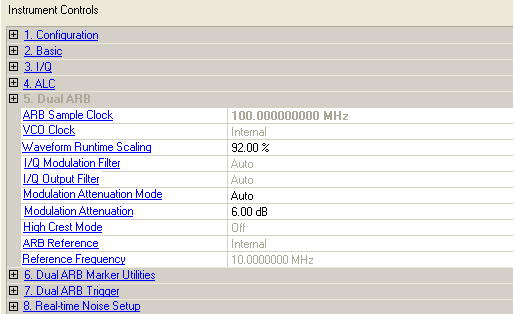

5. Dual ARB: Baseband Frequency Offset (EXT)
Range: 1 kHz to 125 MHz
Default: 100 MHz
Displays the sampling clock frequency of the signal generator, which is automatically calculated by the software.
Selections: Internal | External
Default: Internal
Sets the VCO clock to Internal or External.
Internal − the signal generator uses its internal VCO clock.
External − the signal generator uses an external VCO clock.
This parameter is not available for all instrument model numbers and may be grayed out.
Range: 1% to 100%
Default: 92%
Reduces the overshoot associated with the digital-to-analog convertor (DAC) interpolation filter. Use this cell after downloading and synchronizing with the signal generator.
Enter a scaling value for the signal generator to apply to the waveform while it is playing. Use scaling to get the best dynamic range without overflowing the I and Q digital to analog converters. At 100 percent, some overshoot may occur; therefore the default setting is 92 percent.
Selections: Auto | 2.1 MHz | 40 MHz | Through
Default: Auto
Selects a filter for I/Q signals modulated onto the RF carrier. The bandwidth of the baseband signal should dictate the minimum reconstruction filter bandwidth you choose. Depending on the oversampling ratio and where the image frequencies appear, you may want to select a wider bandwidth.
Auto − automatically selects a digital modulation filter.
2.1 MHz − applies a 2.1 MHz baseband filter to the I/Q signals.
40 MHz − applies a 40 MHz baseband filter to the I/Q signals.
Through − bypasses filtering.
This parameter is not available for all instrument model numbers and may be grayed out.
Selections: Auto | 40 MHz | Through
Default: Auto
Selects a filter or through path for routing I and Q signals to the I/Q outputs.
Auto − automatically selects an I/Q output filter.
40 MHz − applies a 40 MHz baseband filter.
Through − bypasses filtering.
This parameter is not available for all instrument model numbers and may be grayed out.
Selections: Auto | Manual
Default: Auto
Selects the mode of the internal I/Q modulator. Use this cell after downloading and synchronizing with the signal generator.
Manual − manually set the attenuation level of the I/Q modulator using the Modulation Attenuation cell.
Auto − the attenuation level automatically sets to a value for best performance based on the digital modulation settings.
Range: 0.00 to 40.00 dB
Default: 6.00 dB
Sets the attenuation of the I/Q signals being modulated through the signal generator RF path. Adjusting the attenuation may reduce signal distortion and improve the overall dynamic range.
Use this cell after downloading and synchronizing with the signal generator.
Selections: Off | On
Default: Off
Enables or disables the high crest mode.
− processes high-crest-factor arbitrary I/Q waveforms with less distortion. For crest factors higher than 4 dB, you should reduce I/Q Modulation Attenuation levels by 1 dB for each dB above that level. High crest mode reduces the maximum output level and degrades power level accuracy.
− disables the high crest mode.
This parameter is not available for all instrument model numbers and may be grayed out.
Choice: Internal | External
Default: Internal
Sets the reference frequency source for the signal generator.
− the signal generator uses its internally generated 10 MHz signal as the reference source.
− the signal generator uses an external signal as the reference frequency for the baseband I/Q signal. See the signal generator’s User’s Guide for information on external references.
This parameter is not available for all instrument model numbers and may be grayed out.
Range: 0.250 to 100 MHz
Default: 10.00 MHz
Sets the frequency value when using an externally-supplied reference signal. See the signal generator’s User’s Guide for information on external references.
Set ARB Reference to to enable this parameter.
This parameter is not available for all instrument model numbers and may be grayed out.
Range: -50.00 MHz to 50.00 MHz
Default: 0.000 Hz
Set to to enable this parameter.
Enter a frequency value by which the baseband frequency is offset relative to the carrier. This parameter is only available when connected to the E6607 EXT.